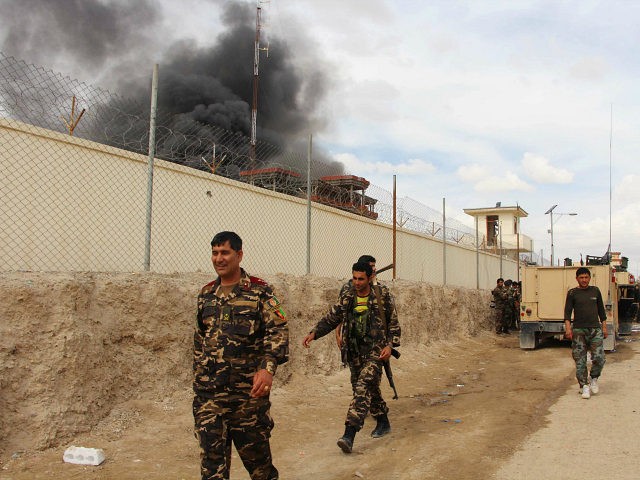Nearly 100 members of the corrupt U.S.-funded Afghan National Defense and Security Forces (ANDSF) were executed by the Taliban as they tried to flee a town near the besieged capital of Helmand, a province that has remained an important Taliban stronghold throughout the 15-year-old war and is currently at risk of falling back into the hands of the jihadists, reports Reuters.
Meanwhile, dozens of other ANDSF surrendered themselves and at least 22 likely U.S.-supplied armored Humvees, dozens of trucks, and hundreds of rifles, an unnamed senior Afghan security official told the news outlet.
The battle reportedly took place on Tuesday in the town of Chah-e-Anjir, about [7 miles] outside the Helmand provincial capital city of Lashkar Gah.
“We were one battalion there and, except me and two others, no one came out alive,” Faiz Mohammad, a visually wounded Afghan army soldier who survived the ambush, told Reuters.
The elite special forces unit in Helmand, known as the 215th Corps at the beginning of this month, noted that his forces had sustained “a lot” of casualties this week, without elaborating further.
According to Reuters, Tuesday’s ambush ended in “the heaviest losses suffered by government forces during months of fierce clashes near the capital of southern Helmand province.”
The Taliban has stepped up their offensive to capture the capital of Helmand, notes The Wall Street Journal (WSJ), firing rockets at government buildings in an effort to make Lashkar Gah the second provincial capital to fall to the Taliban since 2001. The first one, Kunduz city, fell twice, but it is allegedly once again under the control of the Afghans.
WSJ adds that Afghan security forces are being stretched thin as they respond to Taliban attacks in provincial capitals across the country.
According to the U.S. Special Inspector General for Afghanistan Reconstruction (SIGAR), a U.S. watchdog agency appointed by Congress, the U.S.-backed Afghan troops, who are in the lead of security operations despite facing capability gaps, are being sent into battle with some “ghost” troops, a move that limits the number of actual troops on the ground therefore endangering the lives of Afghan and American service members doing the actual fighting.
“Neither the United States nor our Afghan allies truly know how many Afghan soldiers and police are available for duty, or, by extension, the true nature of their operational capability,” SIGARtold lawmakers in April 2015.
SIGAR estimated that of the 319,595 troops who are supposed to be in the ANDSF, nearly 200,000 are “ghost” forces whose salaries are being collected by corrupt officials.
In Helmand alone, Aqa Noor Kintoz, the provincial police chief, said in June that up to half of the tens of thousands of the ANDSF troops who had been deployed to his province at the time were “ghost.”
His predecessor was accused of “exploiting his official powers, establishing ghost police and underestimating his responsibilities in the war with insurgents,” reported TOLO News.
There is no longer mention of tens of thousands of troops in Helmand in recent news articles.
Helmand is one of the deadliest regions of the ongoing war for U.S.-led coalition and Afghan forces. As the largest and top opium producing province, it is an important source of funding for the Taliban, estimated to generate billions.
It is also located in southern Afghanistan along the Pakistan border, making it easier for Taliban jihadists to escape into sanctuaries allegedly sanctioned by Islamabad.
Reuters reports:
Afghan officials say security forces are losing as many as 5,000 people each month through casualties and desertion, while only about 3,000 new soldiers and police are recruited over the same period.
Helmand is also close to fallen back into the hands of the Taliban.
Taliban jihadists, which have a close relationship with al Qaeda and the Haqqani Network, controlled nearly 40 percent of Helmand’s 13 districts as of March, including parts of the capital, The New York Times (NYT) learned from the Afghan security forces.
In July, SIGAR determined that the the Afghan security forces were struggling “to respond to the Taliban’s growing national presence.”
By August, nearly five months after the NYT report, the Taliban was launching attacks “on several fronts” in Helmand and had seized control of “around 80 percent of the province,” doubling their control of the province, Kareem Atal, chief of Helmand’s provincial council, told The Associated Press (AP).
Despite investing nearly $70 billion in U.S. taxpayer funds on the ANDSF, the forces are still unable to “properly” engage the Taliban on the battlefield, noted SIGAR at the of July.
“There are a number of districts that the government claims are under their control, but the government is only present in the district administrative center and all around are under the control of the insurgents,” said Atal, echoing a recent assessment by the U.S. Forces-Afghanistan (USFOR-A) of the situation across the country.
At the end of July, USFOR-A suggested that nearly one-third of Afghanistan is either under insurgent control or influence, primarily the Taliban, or at risk of being so.
In response to the chaos in Helmand, President Barack Obama deployed nearly 100 American troops in late August to the provincial capital of Lashkar Gah, said Brig. Gen. Charles Cleveland, spokesman for U.S. forces in Afghanistan.

COMMENTS
Please let us know if you're having issues with commenting.